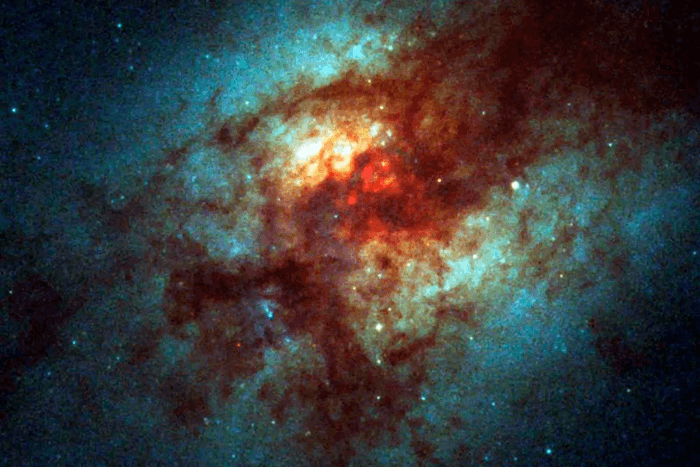
A Powerful ‘Space Laser’ Has Been Detected Beaming From Deep Space
5 BILLION light years!
By Michelle Starr | Science Alert
Powerful, radio-wavelength laser light has been detected emanating from the greatest distance across deep space yet.
It’s a type of massless cosmic object called a megamaser, and its light has travelled for a jaw-dropping 5 billion light-years to reach us here on Earth. The astronomers who discovered it using the MeerKAT radio telescope in South Africa have named it Nkalakatha – an isiZulu word meaning “big boss“.
The discovery has been accepted into The Astrophysical Journal Letters and is available on preprint server arXiv.
“It’s impressive that, with just a single night of observations, we’ve already found a record-breaking megamaser,” said astronomer Marcin Glowacki of the Curtin University node of the International Centre for Radio Astronomy Research (ICRAR) in Australia.
“It shows just how good the telescope is.”
A maser is the microwave equivalent of a laser (light amplification by stimulated emission of radiation). Rather than emitting visible light, a maser emits microwave and radio wavelengths that are stimulated and amplified. For an astrophysical maser, the processes that amplify the light are cosmic; planets, comets, clouds, and stars can all produce masers.
As you may have guessed it, a megamaser is therefore a maser with some serious oomph. Generally these emissions are produced by an object that is going absolutely ham in some way; for instance, active supermassive black holes can produce megamasers.
When the data came in from the first night of a survey planned for 3,000 hours, Glowacki and team found the signature of a very specific type of megamaser, bright in wavelengths amplified by stimulated hydroxyl molecules, consisting of one hydrogen atom and one oxygen atom.
Hydroxyl megamasers have a known production mechanism. They are emitted by galaxies that are in the process of, or have recently undergone, a collision with another galaxy, and are bursting with star formation as a result. The gravitational interactions of such a massive encounter compress star-forming gas, causing it to collapse down into baby stars at a tremendous rate.
The source of the megamaser detected by Glowacki and his colleagues is just that, a galaxy named WISEA J033046.26−275518.3 – now known as Nkalakatha.
“When two galaxies like the Milky Way and the Andromeda Galaxy collide, beams of light shoot out from the collision and can be seen at cosmological distances,” said astrophysicist Jeremy Darling from the University of Colorado.
“The hydroxyl megamasers act like bright lights that say: here is a collision of galaxies that is making new stars and feeding massive black holes.”
The MeerKAT survey was not designed to look for megamasers. It’s called Looking at the Distant Universe with the Meerkat Array (LADUMA), and it’s looking for a 21-centimeter wavelength emitted by neutral hydrogen in the early Universe, stretched (redshifted) by the expansion of the Universe.
The wavelengths of a hydroxyl megamaser are, however, 18 centimetres; when they’re redshifted, they’re even longer, and that redshifted signal was within the range detectable by the telescope array.
Since the region of sky has been extensively observed in other wavelengths, tracking the signal down to a host galaxy was fairly straightforward. Nkalakatha is bright in infrared wavelengths, and has a long tail on one side that glows brightly in radio, likely as the result of being pulled by the gravitational interaction between the two now-merged galaxies.
The team has already planned follow-up observations of the fascinating object, and expect to find many more megamasers as the survey continues.
“MeerKAT will probably double the known number of these rare phenomena,” Darling said. “Galaxies were thought to merge more often in the past, and the newly discovered hydroxyl megamasers will allow us to test this hypothesis.”
The research has been accepted into The Astrophysical Journal Letters and is available on arXiv.
This article was originally published by Science Alert.
